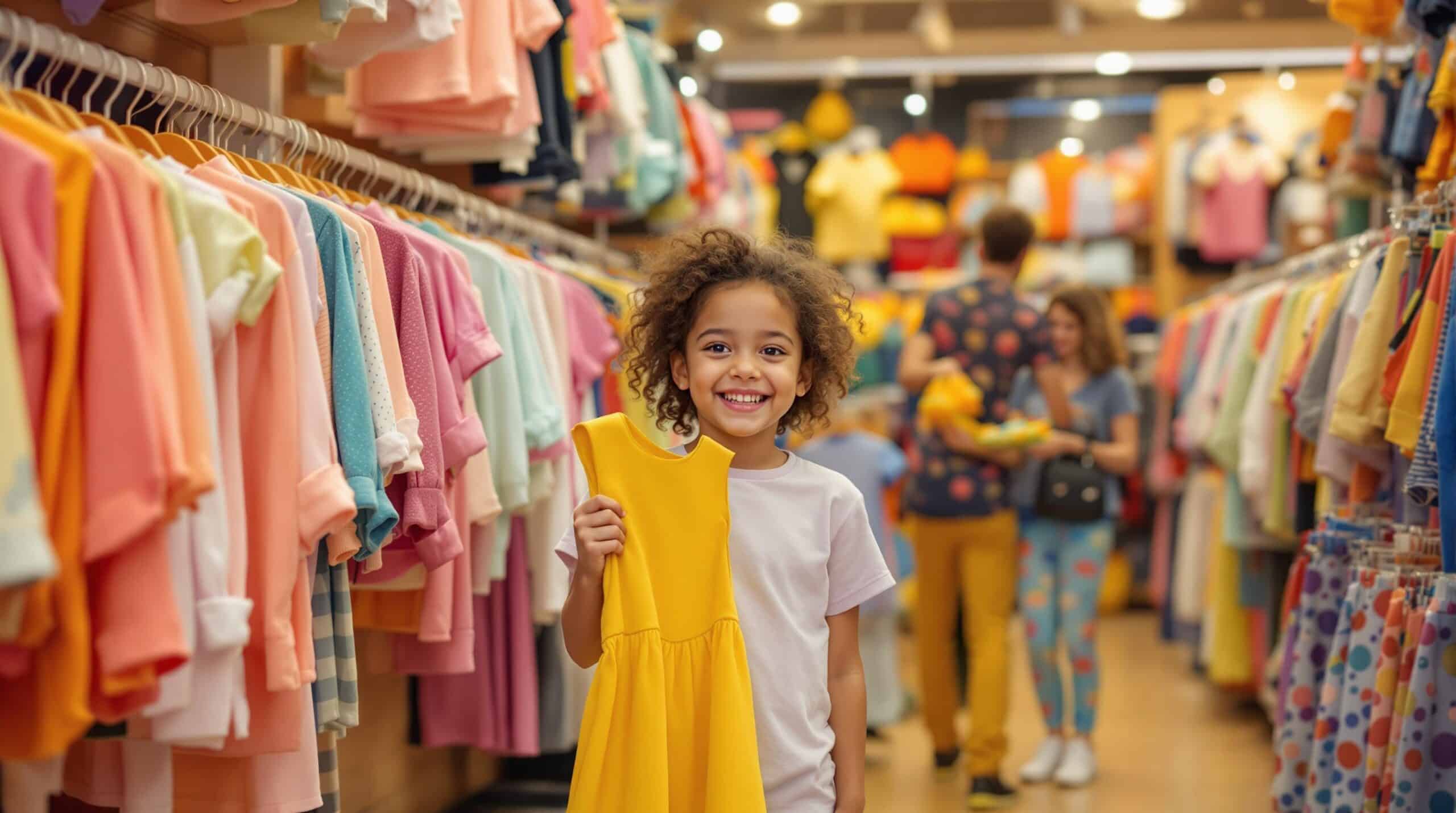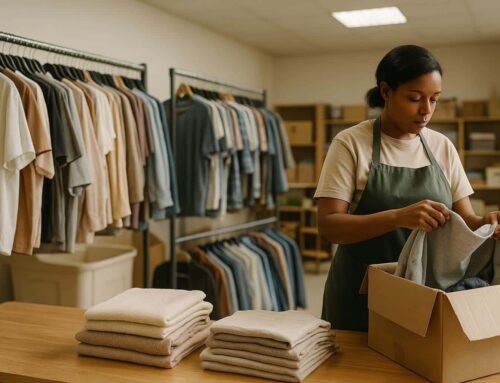Kids grow fast, and clothing costs can add up quickly – up to $1,500–$2,000 per child annually. Shopping at thrift stores like City Thrift can save you 50–80% on kids’ clothes compared to retail. Plus, thrifting helps reduce waste, conserve resources, and support local programs.
Quick Comparison:
| Shopping Factor | Retail | Thrift (e.g., City Thrift) |
|---|---|---|
| Price | Full retail price | 50–80% off retail |
| Environmental Impact | Higher | Lower |
| Community Support | Limited | Funds local initiatives |
For example, a $40 pair of jeans at retail costs just $5 at City Thrift. Over a year, you can save $140+ per child by thrifting. And with simple tips – like checking seams, fabric quality, and elasticity – you can find durable, stylish clothes that last.
Thrifting is more than saving money. It reduces landfill waste, saves resources, and contributes to local community programs. Start saving today by shopping smart, sticking to a plan, and choosing secondhand over retail.
Price Differences
At City Thrift, you’ll find kids’ jeans for $3–$8, t-shirts for $1–$4, jackets for $5–$12, and shoes for $2–$6. That’s 50–80% less than what you’d pay at a department store.
For example, swapping a $40 department-store pair of jeans for a $5 thrift-store find means a $35 savings. Refresh your child’s wardrobe four times a year, and you’re looking at saving over $140 per child annually. Plus, every dollar spent at City Thrift helps fund local youth programs.
Next, we’ll look at how these individual savings can add up to a big difference in your yearly budget.
Finding Good Quality Kids’ Clothes
Saving money is great, but not if the clothes wear out too quickly. Here’s how to find sturdy, stylish thrifted pieces that last.
Name Brands at Lower Prices
Thrift stores often stock well-known kids’ brands at a fraction of their original price. Prioritize items made with natural fibers like cotton, wool, silk, denim, or linen. These materials tend to be more comfortable and hold up better over time. Look for garments with reinforced stitching for added durability.
How to Check Clothing Quality
Before buying, use these simple checks to ensure you’re getting good-quality clothes:
- Inspect seams: Pay attention to high-stress areas like underarms and knees. Avoid items with loose threads or uneven stitching.
- Examine fabric: Watch out for pilling, fading, thinning, stains, or holes, especially in spots that experience heavy wear.
- Test elastic: Stretch waistbands, cuffs, and hems to make sure they still have good elasticity.
- Use the light test: Hold lighter-colored items up to bright light to spot hidden stains or discoloration, particularly around collars and cuffs.
With these tips in mind, you’re set to shop smart and build a wardrobe that’s both affordable and reliable.
Smart Thrift Shopping Steps
City Thrift restocks every weekend, so the best time to shop is Monday mornings when the inventory is fresh.
- Visit during weekday mornings to avoid crowds.
- Ask staff about any discount days or promotions.
- Check City Thrift’s website or call ahead to confirm restock and sale schedules.
Building a Basic Wardrobe
Start with a plan. Make a list of what you already have and what you need. Break it down into categories like everyday basics, school clothes, play outfits, and special occasion pieces. This helps you focus on the essentials and avoid unnecessary purchases. Look for durable fabrics and timeless styles to save money in the long run.
Keep your shopping list simple and stick to immediate needs.
Smart Shopping Tips:
- Dress your child in fitted clothes to make trying on items easier.
- Decide on a spending limit before you begin browsing.
- Focus on one section at a time to keep things manageable and stress-free.
Making a Difference Through Thrifting
Thrifting isn’t just about saving money – it also has a meaningful impact on the planet and local communities.
Cutting Down on Clothing Waste
The amount of children’s clothing that ends up in landfills is staggering. In the U.S., over 13 million tons of clothing are discarded each year, with each person tossing out 60–80 pounds of textiles annually. Manufacturing new clothes takes a toll on resources, too – producing a single T-shirt uses over 400 gallons of water, and a pair of jeans requires more than 1,800 gallons. By purchasing second-hand items, you’re helping extend the life of textiles and conserving valuable resources.
How City Thrift Supports the Community
Shopping at City Thrift goes beyond finding affordable clothes. Every purchase helps fund programs that address homelessness and poverty in your area. Your dollars contribute to:
- Warm beds for those in need
- Nutritious meals for families
- Safe spaces for vulnerable individuals
- Resources that promote long-term well-being
“The proceeds from your purchases support life-changing programs and make a difference in your community.”
– City Thrift
When you buy kids’ clothing from City Thrift, you’re doing more than saving money. You’re contributing to a cycle of community support that helps families in need while keeping your costs down. It’s a win-win: affordable clothing for your children and a positive impact on both the environment and your local community.
Final Thoughts
Shopping at City Thrift for kids’ clothing is a great way to save money while making a positive impact. You can find quality clothes for growing children at a fraction of the cost of retail, which is especially helpful when kids outgrow outfits so quickly.
Plus, every purchase supports local programs that assist families dealing with homelessness and poverty.
Make it a habit: shop for quality secondhand items and donate clothes your kids have outgrown. It’s an easy way to save money and give back to your community.
FAQs
How can I find high-quality kids’ clothes when shopping at thrift stores?
To find high-quality kids’ clothes while thrifting, focus on natural fabrics like cotton, wool, or silk, as they tend to be more durable and comfortable. Check the clothing for signs of wear, such as fraying seams, stains, or missing buttons, to ensure you’re getting items in good condition.
Pay attention to well-known brands that are known for quality and longevity, as these items are often built to last. Also, look for sturdy stitching and reinforced areas like knees or elbows, especially for active kids. Taking a little extra time to inspect each piece can help you find stylish, durable, and budget-friendly options for your growing child.
How does shopping at thrift stores help the environment?
Shopping at thrift stores is an eco-friendly choice that helps protect the environment in several ways. By purchasing second-hand clothes, you help reduce the amount of clothing that ends up in landfills, cutting down on waste. Thrifting also lowers the demand for new clothing production, which conserves valuable resources like water, energy, and raw materials.
Additionally, buying pre-loved items minimizes the pollution caused by manufacturing processes in the fashion industry. Choosing thrift stores not only saves money but also supports a more sustainable and responsible way of shopping.
How do thrift store purchases benefit the community?
When you shop at thrift stores, your purchases often contribute directly to community programs. Many thrift stores are operated by charitable or non-profit organizations, using the proceeds to fund initiatives like helping individuals transition out of homelessness or supporting job training programs.
Additionally, thrift stores make it easier for families to access affordable clothing, furniture, and household essentials, offering a practical solution for those on tight budgets. By shopping second-hand, you’re not only saving money but also supporting meaningful causes that strengthen your community.





